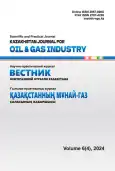Polymercationic Drilling Fluids for Well Construction in Challenging Mining and Geological Conditions
- Authors: Yaremko A.V.1, Karabalin U.S.2, Yussubaliev R.3, Gaidarov A.M.1
-
Affiliations:
- Asia Petro Service
- Kazenergy
- KazNIGRI
- Issue: Vol 6, No 4 (2024)
- Pages: 87-97
- Section: Drilling
- URL: https://bakhtiniada.ru/2707-4226/article/view/277981
- DOI: https://doi.org/10.54859/kjogi108787
- ID: 277981
Cite item
Full Text
Abstract
Background: Oil and gas well drilling involves the use water- and hydrocarbon-based drilling fluids for flushing. While hydrocarbon solutions offer several advantages—such as preventing rock softening on the wellbore walls, reducing the formation of caverns due to instability in clay rocks, and dissoving salts (like halite, sylvinite, and bischofite), and preserving the natural reservoir properties of productive formations—they also have significant drawbacks. These disadvantages are related to the properties of the dispersion medium, which limits their overall application. The dispersion medium in hydrocarbon solutions consist of compounds that are both environmentally and flammable, such as kerosene, diesel fuel, olefins, various oils, etc. Increasing concern from government and environmental organizations regarding the environmental impact of drilling fluids using hydrocarbon dispersion medium have promted the industry to focus on water-based solutions. Despite several significant disadvantages, water-based drilling fluids are still more in demand than hydrocarbon ones. Although there is a preference for hydrocarbon systems, approximately 85% of all drilling fluids used worldwide today are water-based. This study focuses on a new approach in the field of water-based drilling fluids: the development, creation and implementation of polymer cationic systems. The idea of developing new water systems involves creatng polymer cationic working fluids that combine the beneficial properties of hydrocarbon and aqueous solutions.
Aim: To research and develop modern polymer cationic drilling fluids for well construction in the Republic of Kazakhstan.
Materials and methods: Polymer cationic drilling fluids were selected as the objects of study. To address the research objectives, experiments were conducted under both laboratory and field conditions.
Results: This article presents the findings of laboratory tests and field trials conducted in the fields of the Russian Federation and the Republic of Kazakhstan.
Conclusion: For the first time in global practice, stable polymer cationic drilling fluids have been developed and successfully tested, combining the advantages of aqueous and hydrocarbon systems. Both theoretical and practical principles for managing the properties of polymer cationic solutions have been established. The application of modified polymer cationic drilling fluids in well construction at the at the Astrakhan field and the Uzen field has demonstrated their high performance. This innovation has enabled the prevention of production isuues, increased mechanical speed of drilling, improved wellbore condition, reduced cavern porosity, and successfully completed the construction of over 20 wells. Additionally, it facilitated implementation of high-density solutions for killing brine and other related tasks.
Full Text
##article.viewOnOriginalSite##About the authors
Artem V. Yaremko
Asia Petro Service
Author for correspondence.
Email: a.yaremko@asiapetroservice.kz
ORCID iD: 0009-0009-3842-6000
https://www.asiapetroservice.kz
Kazakhstan, Aktau
Uzakbai S. Karabalin
Kazenergy
Email: u.karabalin@kazenergy.com
ORCID iD: 0000-0002-7471-7851
Doct. Sc. (Engineering)
Kazakhstan, AstanaRenat Yussubaliev
KazNIGRI
Email: yussubaliev.r@kaznigri.kz
ORCID iD: 0009-0003-7029-5537
Kazakhstan, Atyrau
Azamat M. Gaidarov
Asia Petro Service
Email: a.gaidarov@asiapetroservice.kz
ORCID iD: 0009-0008-0298-0133
PhD
Kazakhstan, AktauReferences
- Gaydarov MMR, Khubbatov AA, Gaydarov AM, et al. Recommendations for evaluation of inhibiting and strengthening (casing) properties of the drilling fluid. Oil Industry Journal. 2019;2(114):33–38. doi: 10.24887/0028-2448-2019-2-33-38.
- Zlatina VY. Analiz effektivnosti primeneniya sovremennykh burovyh rastvorov dlya povysheniya kachestva bureniya nadsolevogo kompleksa v strukturnoy zone Pripyatskogo progiba. MITRo 2022 – Mashinostroenie. Innovacii. Tekhnologii. Robototekhnika; 2022 Dec 1; Gomel'. Available from: https://elib.gstu.by/handle/220612/29444?locale-attribute=en. (In Russ).
- Khubbatov AA, Gaydarov AM, Norov AD, Gaydarov MMR. K voprosu ob ustojchivosti glinistyh porod. Territoriya Neftegaz. 2014;5:22–32. (In Russ).
- Gaydarov AM, Hubbatov AA, Hrabrov DV, et la. Polikationnye sistemy Katburr – novoe napravleniye v oblasti burovykh rastvorov. Onshore and offshore oil and gas well construction. 2017;7:36–49. (In Russ).
- Macovei N. Hidraulica Forajului. 1982. București: TEHNICA; 495 p.
- Ivanov DY, Marusov MA, Moysa YN, et al. Ingibirovaniye glin pri stroitel'stve skvazhin. Onshore and offshore oil and gas well construction. 2023;3(364):28–34. (In Russ).
- Gaydarov AM, Kadyrov NT, Khubbatov AA, et al. Applying rheological indicators of polycationic muds. Scientific and technical collection of gas science news. 2021;2(47):138–148. (In Russ).
- Gaydarov MMR, Kirshin VI, Kuligin AV, et al. Kationnye burovye rastvory dlya bureniya glinistykh otlozheniy. Gazovaya promyshlennost'. 2014;9:114–119. (In Russ).
- Osipov VI, Sokolov VH, Rumyantseva NA. Mikrostruktura glinistyh porod. Sergeev EM, editor. Moscow: Nedra; 1989. 211 p. (In Russ).
- Privedenny MV, Beketov SB, Yaremko AV, et al. Burovye rastvory na osnove nitrata kal'tsiya s dobavkami asfal'tenov i ingibitorov HBN. Onshore and offshore oil and gas well construction. 2024;3(375):41–46.
- Trofimov VT, Korolev VA, Voznesenskiy EA, et al. Gruntovedeniye. 6th edition. Trofimov VT, editor. Moscow: MSU publisher; 2005. 1024 p. (In Russ).
Supplementary files













